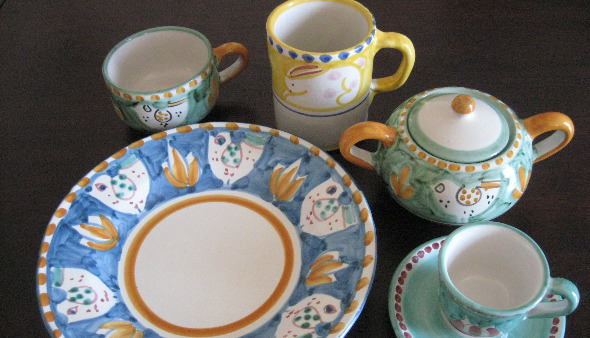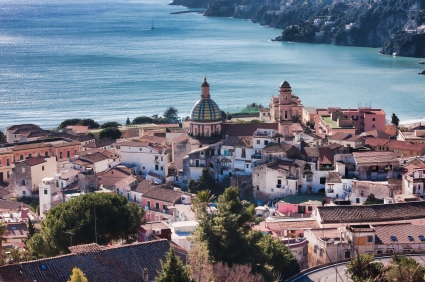I’ve always loved the Vietri ceramics and have brought them with me wherever I’ve lived! Here is a small sample of my collection and I’ve even bought them for friends as weddings gift. They are definitely unique.
Known as the “Gateway to the Amalfi Coast”, the town of Vietri sul Mare is a paradise for ceramic lovers. Spilling down the mountainside to the sea with twisting roads and colorful houses, the heart of the town is decorated with the bright yellow and blue majolica-tiled dome and bell tower of the church of San Giovanni Battista. This is the first sign that you’ve arrived in a town famous for ceramics.
Walking through the streets of town, you’ll come across countless more signs, from the brightly colored ceramic murals and religious shrines decorating homes and small shops to the hand designed ceramic street signs.
Head to Via Madonna degli Angeli, a street closed off to traffic and lined with one ceramic shop after another, each one more colorful than the next. Look closely and you’ll see that each shop is slightly different, featuring the work of various artists and styles. This street is where to come for ceramic shopping on the Amalfi Coast.
Vietri sul Mare has been an important center for ceramic production in southern Italy since the 15th century, and today it is known as the ceramic capital of the Campania region. Ceramics became a major industry for Vietri sul Mare in the 16th and 17th centuries when the work of the local craftsmen became popular in royal circles in Naples, which turned the small fishing town into a flourishing center for ceramics.
In the 18th century, many artisans specialized in hand painted murals of saints and religious scenes, which you’ll find in churches and pretty street shrines in Vietri sul Mare and throughout the Amalfi Coast.
In the early 20th century, the arrival of many international artists, especially from Germany, blew a breath of fresh air into the ceramics production in Vietri sul Mare beginning in the 1920s through about 1947.
This time period and subsequent revival is referred to as the German Period in Vietri ceramics, and is known for the new creative influences and rebirth of the appreciation of the ceramic tradition in the town.
One of Vietri sul Mare’s most famous factories is the Ceramica Artistica Solimene, which is located in an unmistakable building designed in 1954 by Paolo Soleri covered in brightly colored circular ceramic tiles and glass.
Soleri studied briefly with the American architect Frank Lloyd Wright whose late modern work influenced the design for the Solimene factory. Inside you’ll find an excellent showroom of ceramic designs and works of arts in all shapes and sizes.
One favorite with many visitors are the Campagna (country) dinnerware dishes featuring animals such as fish, rabbits, birds, cows and chickens rendered in bright Mediterranean colors and bold brushstrokes.

Ceramics from Vietri
To discover more about Vietri sul Mare’s ceramic traditions, head to the Museo della Ceramica in the nearby section of Vietri called Raito. The collection displays works from Vietri sul Mare and the surrounding area from the 17th century to modern designs from the German Period, and is housed in the beautiful Villa Guariglia surrounded by gardens.
If you would like to get your hands on some ceramics for yourself or as a present for friends, click here for some collection of Vietri ceramics. I have similar ones with animals which I simply love!
 BrowsingRome Blogging about my experiences and sharing my thoughts about Rome, Italy and beyond
BrowsingRome Blogging about my experiences and sharing my thoughts about Rome, Italy and beyond

i just came back from the amalfi coast and am very upset that I did not buy a plater dish. Can you help me as to how about calling or writing or going on email mail to order one. I like the ones with the fruits or sea coast. thanks
Hi Ina, sorry to hear you weren’t able to buy some plater dish. There are some sites online that handles sales of these plates. One place is this but I have never bought from them so I can vouch as to whether they are reliable http://www.ceramichedarte.com/default.asp Hope that helps